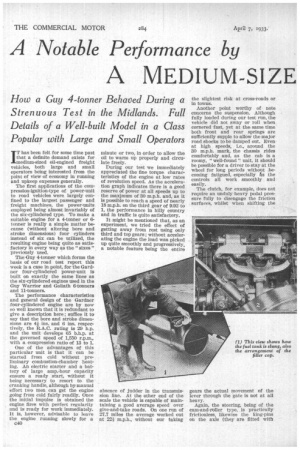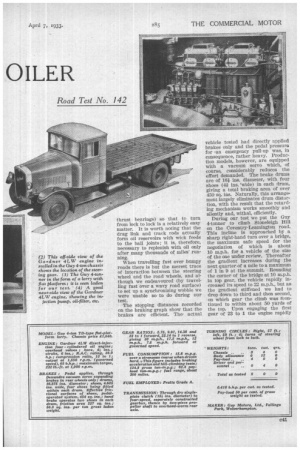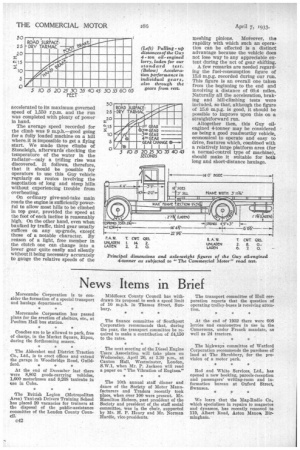A Notable Performance by
Page 62

Page 63

Page 64

If you've noticed an error in this article please click here to report it so we can fix it.
A MEDIUM-SIZE OILER
How a Guy 4-tonner Behaved During a Strenuous Test in the Midlands. Full Details of a Well-built Model in a Class Popular with Large and Small Operators
IT has been felt for some time past that a definite demand exists for
medium-sized oil-engined freight vehicles, both large and small operators being interested from the point of view of economy in running and upkeep expenses generally.
The first applications of the compression-ignition-type of power-unit to road vehicles were largely confined to the largest passenger and freight machines, the power-units employed being almost invariably of the six-eylindered type. 'To make a suitable engine for a 4-tonner or 6tonner is really a simple matter because (without altering bore and stroke dimensions) four cylinders instead of six can be utilized, the resulting engine being quite as satisfactory in every way as the "sixes" previously used.
The Guy 4-tonner which forms the basis of our road test report this week is a case in point, for the Gardner four-cylindered power-unit is built on exactly the same lines as the six-cylindered engines used lit the Guy Warrior and Goliath 6-tonners and 11-tonners.
The performance characteristics and general design of the Gardner four-cylindered engine are by now so well known that it is redundant to give a description here ; suffice it to say that the bore and stroke dimensions are 4,/ ins. and 6 ins, respectively, the R.A.C. rating is 29 h.p. and the unit develops 65 b.b.p. at the governed speed of 1,550 r.p.m., with a compression ratio of 13 to 1.
One of the advantages of this particular unit is that it can be started from cold without preliminary combustion-chamber heating. An electric starter and a battery of large amp.-hour capacity ensure a ready start, without it being necessary to resort to the• cranking handle, although by. manual effort two men can get the engine going from cold fairly readily. Once the initial impulse is obtained the engine fires with perfect regularity and is ready for work immediately. It is, however, advisable to leave the engine running slowly for a
c40 minute or two, in order to allow the oil to warm up properly and circulate freely.
During our test we immediately appreciated the fine torque characteristics of the engine at low rates of revolution speed. As the acceleration graph indicates there is a geed reserve of power at all speeds up to the maximum of 30 m.p.h. and, as it is possible to reach a speed of nearly 18 m.p.h. on the third gear of 9.92 to 1, the performance in hilly country and in traffic is quite satisfactory.
It might be mentioned that, as an experiment, we tried the effect of getting away from rest using only third and top gears; without accelerating the engine the load was picked up quite smoothly and progressively, a notable feature being the entire
absence of judder in the transmission line. At the other end of the scale the vehicle is capable of maintaining a good average speed over give-and-take roads. On one run of 27.7 miles the average worked out at 22i m.p.h., without our taking the slightest risk at cross-roads or in towns.
Another point worthy of note concerns the suspension. Although fully loaded during our test run, the vehicle did not sway or roll when cornered fast, yet at the, same time both front and rear springs are sufficiently supple to allow the major road shocks to be damped out. Even at high speeds, i.e., around the 30 m.p.h. mark, the chassis rides comfortably and, as the cab is a roomy, 'well-found " unit, it should be possible for a driver to stay at the wheel for long periods without becoming fatigued, especially As the controls all work smoothly and easily.
The clutch, for example, does not require an unduly heavy pedal pressure fully to disengage the friction surfaces, whilst when shifting the
gears the actual movement of the lever through the gate is not at all heavy.
Again, the steering, being of the cam-and-roller type, is practically frictionless, likewise the king-pins on the axle (they are fitted with
thrust bearings) so that to turn from lock to lock is a relatively easy matter. It is worth noting that the drag link and track rods actually form oil reservoirs with wick feeds to the ball joints ; it is, therefore, necessary to replenish with oil only after many thousands of miles' running.
When travelling fast over bumpy roads there is but the merest trace of interaction between the steering wheel and the road wheels, and although we endeavoured (by travelling fast over a wavy road surface) to set up a synchronizing wobble we were unable so to do during our test.
The stopping distances recorded on the braking graph show that the brakes are efficient. Theactual vehicle tested had directly applied brakes only and the pedal pressure for ;an emergency pull-up was, in consequence, rather heavy. Production models, however, are equipped with a vacuum servo which, of course, considerably reduces the effort demanded. The brake drums are of 16i ins, diameter, with four shoes (41 ins. 'wide) in each drum, giving a total braking area of over 450 sq. ins. Naturally, this arrangement largely eliminates drum distortion, with the result that the retarding mechanism works smoothly and silently and, withal, efficiently.
During our test we put the Guy 4-tonner to climb Stoneleigh Hill on the Coventry-Leamington road. This incline is approached by a sharp right-hand turn over a bridge, the maximum safe speed for the negotiation of which is about 10 m.p.h. for a vehicle of the size of the one under review. Thereafter the gradient increases during the next quarter-of a mile to a maximum of 1 in 9 at the summit. Rounding the corner of the bridge at 10 m.p.h. in top gear, the vehicle rapidly increased its speed to 22 m.p.h., but as the gradient stiffened we had to drop down to third and then second, on which gear the climb was feantinned to within about 50 yards of the top. Upon engaging the first gear of 23 to 1 the engine rapidly accelerated to its maximum governed speed of 1,550 r.p.m. and the run was completed with plenty of power In hand.
The average speed recorded for the climb was 9 m.p.h.—good going for a fully loaded machine on a hill where, it is impossible to get a flying start. We made three climbs of Stoneleigh, afterwards checking the temperature of the water in the radiator—only a trifling rise was discovered. It follows, therefore, that it should be possible for operators to use this Guy vehicle regularly on routes involving the negotiation of long and steep hills without experiencing trouble from overheating.
On ordinary give-and-take main roads the engine is sufficiently powerful to allow most hills to be climbed in top gear, provided the speed at the foot of each incline is reasonably high. On the other hand, even when baulked by traffic, third gear usually suffices on any up-grade, except those of a notable character. By reason of a light, free member in the clutch one can change into a lower gear quite easily and silently without it being necessary accurately to gauge the relative speeds of the meshing pinions. Moreover, the rapidity with which such an operation can be effected is a distinct advantage because the vehicle does not lose way to any appreciable extent during the act of gear shifting.
A few remarks are needed regarding the fuel-consumption figure of 15.6 m.p.g. recorded during our run. This figure is an overall one taken from the beginning to the end and involving a distance of 60.4 miles. Naturally all the acceleration, braking and hill-climbing tests were included, so that, although the figure of 15.6 m.p.g. is good, it should be possible to improve upon this on a straightforward run.
Altogether then, this Guy oilengined 4-tonner may be considered as being a good roadworthy vehicle. economical to operate and easy to drive, features which, combined with a relatively large platform area (for a normal-control type of machine). should make it suitable for both long and short-distance haulage.












































































































